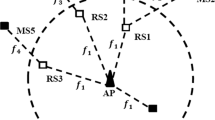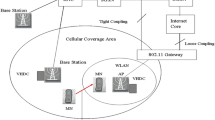Abstract
The seamless vertical handoff from a wireless local area network (WLAN) to a cellular system yet poses a big challenge. While serving by a WLAN, a mobile node (MN) may enter a region with a low data rate before completing a handoff towards a cellular network. To maintain quality of service, a large amount of WLAN bandwidth must be allocated to compensate for the weakness of MN link. However, this mechanism does not work properly in dense hotspots because of the lack of WLAN bandwidth. An alternative is to employ relay nodes (RN) to remain connected to the AP. This scheme also does not operate well in a low-density hotspot because the chance of finding a suitable RN is low. In this paper, a hybrid solution that uses both WLAN bandwidth and potential RNs is proposed. It uses the trade-off between the WLAN bandwidth and the potential RNs to reach an optimum handoff performance in terms of call dropping probability. Initially, the probability of call dropping in relay mode is theoretically evaluated and compared with the simulation results. Next, the proposed Hybrid approach is modelled by assuming 5% and 10% of nods as the relay nodes. The results show the proposed method can significantly reduce call dropping probability in both low and high-density hotspots when compared with a relay or bandwidth-based approach. It also reduces new call blocking probability of the bandwidth only but slightly worse than the relay only methods.









Similar content being viewed by others
References
Shiri, M., & Berangi, R. (2020). WLAN bandwidth support for relay-based upward handover in WLAN/cellular systems. AEU-International Journal of Electronics and Communications, 116, 100. https://doi.org/10.1016/j.aeue.2020.153067.
Wu, Y., Qian, L. P., Huang, J. & Shen, X. S. (2017). Radio resource management for mobile traffic offloading in heterogeneous cellular networks. Springer Briefs in Electrical and Computer Engineering, ISBN: 978-3-319-51036-1.
Willemen, P., Laselva, D., Wang, Y., Kovacs, I., Djapic, R., & Moerman, I. (2016). SON for LTE-WLAN access network selection: Design and performance. EURASIP Journal on Wireless Communications and Networking. https://doi.org/10.1186/s13638-016-0726-x.
Ahmad, R., Sundararajan, E. A., Othman, N. E., & Ismail, M. (2018). An efficient handover decision in heterogeneous LTE-A networks under the assistance of users’ profile. Telecommunication Systems, 68, 27–45.
Smadi, M., Azhari, V., Todd, T. D., & Kezys, V. (2009). A study of WLAN to cellular handoff using measured building exit data. IEEE Transactions on Vehicular Technology, 54, 2044–2054.
Kim, Y. S., Kwon, D. H., & Suh, Y. J. (2010). A client-based vertical handoff approach for seamless mobility across heterogeneous wireless networks. Wireless Communications and Mobile Computing, 10, 1208–1220.
Fernndez, P. J., Santa, J., Pereguez, F., & Antonio, F. S. (2017). Towards seamless inter-technology handoffs in vehicular IPv6 communications. Computer Standards & Interfaces, 52, 85–96.
Roy, S. D. & Anup, S. (2012). Received signal strength based vertical handoff algorithm in 3G cellular network. In Proceeding of IEEE international conference on signal processing, communication and computing (ICSPCC), pp. 326–330.
Nemati, H., Azhari, S. V., Smadi, M. & Todd, T. D. (2010). Trigger node assisted WLAN to cellular vertical handover. In Proceeding of IEEE 72nd vehicular technology conference-fall (VTC 2010 Fall), pp. 1–5.
Khadivi, P., Todd, TD. & Zhao, D. (2004). Handoff trigger nodes for hybrid IEEE 802.11 WLAN/Cellular Networks. In Proceeding of the 1st international conferance on quality of service in heterogeneous wired/wireless networks (Qshine 2004) pp. 164–170.
Khadivi, P., Todd, T. D., Samavi, S., Saidi, H., & Zhao, D. (2008). Mobile ad hoc relaying for upward vertical handoff in hybrid WLAN/cellular systems. Ad Hoc Networks, 2, 307–324.
Choi, H. H. (2015). Ad hoc cooperative vertical handoff for next-generation heterogeneous networks. AEU - International Journal of Electronics and Communications, 69, 1557–1561.
Shiri, M., & Berangi, R. (2020). Vertical handoff from WLAN to cellular network based on relay environment. Arabian Journal for Science and Engineering, 45, 6259–6272. https://doi.org/10.1007/s13369-020-04470-1.
Ahmed, H., Pierre, S., & Quintero, A. (2018). A cooperative road topology based handoff management scheme. IEEE Transactions on Vehicular Technology. https://doi.org/10.1109/TVT.2018.2872824.
Alfarraj, O., Tolba, A., Alkhalaf, S., & Alzubi, A. (2019). Neighbor predictive adaptive handoff algorithm for improving mobility management in VANETs. Computer Networks. https://doi.org/10.1016/j.comnet.2019.01.020.
Bi, Y. (2018). Neighboring vehicle-assisted fast handoff for vehicular fog communications. Peer-to-Peer Networking and Applications, 11, 738–748.
Huang, R., Zhao, H., & Fang, Y. (2013). Mitigating location management traffic via aggregation in multi-hop cellular networks. Wireless Networks, 19, 1563–1575.
Abdullah, R. M., Zukarnain, Z. A., & Iqbal, Z. (2017). Improved fast handover method for multiple node by using mobile nodes guide. Telecommunication Systems, 64, 429–438.
Xu, S., Zhu, G., Ai, B., & Zhong, Z. (2016). A survey on high-speed railway communications: A radio resource management perspective. Computer Communications, 86, 12–28.
Coluccia, A., & Fascista, A. (2018). On the hybrid TOA/RSS range estimation in wireless sensor networks. IEEE Transactions on Wireless Communications, 17, 361–371.
Golestanian, M., & Poellabauer, C. (2019). VariLoc: Path loss exponent estimation and localization using multi-range beaconing. IEEE Communications Letters. https://doi.org/10.1109/LCOMM.2019.2903042.
Kustiawan, I., & Chi, K.-H. (2015). Handoff decision using a Kalman filter and fuzzy logic in heterogeneous wireless networks. IEEE Communications Letters, 14, 2258–2261.
Wang, Z., Zhang, H., Lu, T., & Gulliver, T. A. (2018). Cooperative RSS-based localization in wireless sensor networks using relative error estimation and semidefinite programming. IEEE Transactions on Vehicular Technology. https://doi.org/10.1109/TVT.2018.2880991.
An, D., Kim, Y., Yoon, H., & Yeom, I. (2014). Partition and cooperation for crowded multi-rate WLANs. Wireless Personal Communications, 79, 1511–1538.
Kar, U. N., & Sanyal, D. K. (2018). An overview of device-to-device communication in cellular networks. ICT Express, 4, 203–208.
Jameel, F., Hamid, Z., Jabeen, F., Zeadally, S., & Javed, M. A. (2018). A survey of device-to-device communications: Research issues and challenges. IEEE Communications Surveys & Tutorials. https://doi.org/10.1109/COMST.2018.2828120.
Broch, J., Maltz, D. A., Johnson, D. B., Hu, Y. C. & Jetcheva, J. (1998). A performance comparison of multi-hop wireless ad hoc network routing protocols. In Proceeding of the fourth annual ACM/IEEE international conference on mobile computing and networking (ACM MOBICOM), pp. 85–97.
Author information
Authors and Affiliations
Corresponding author
Additional information
Publisher's Note
Springer Nature remains neutral with regard to jurisdictional claims in published maps and institutional affiliations.
Rights and permissions
About this article
Cite this article
Shiri, M., Berangi, R. Handoff in WLAN/cellular systems based on a hybrid of WLAN bandwidth and ad hoc relaying strategies. Telecommun Syst 75, 401–410 (2020). https://doi.org/10.1007/s11235-020-00690-w
Published:
Issue Date:
DOI: https://doi.org/10.1007/s11235-020-00690-w




